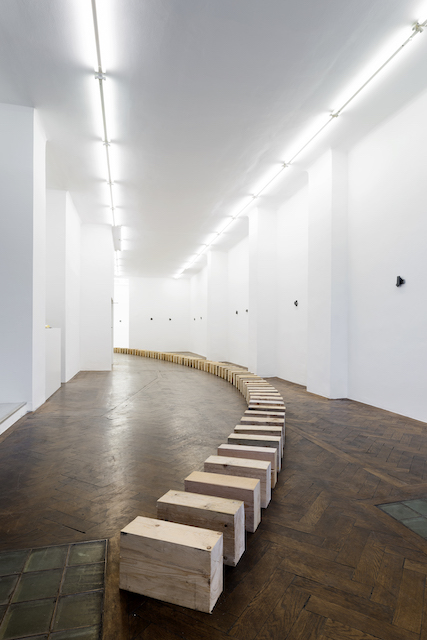Reflections on Minimalism abound as Max L. Feldman takes in new works from the sculptor
Richard Nonas’s sculptures play with some strange dialectics. The veteran American artist, whose work both converses with and diverges from Minimalism, gives with one hand and takes with the other. He reckons the viewer should feel how his works, as he says, ‘create place itself’, distinguishing between ‘space’ (just there without us) and ‘place’ (which is named, used and lives in our collective memory). He wants his sculptures to transform space into place; at the same time, although his poetic verbal and written statements often refer to time, change and memory, the relation between narrative and space is never resolved. It’s unclear how you get from space to place beyond the act of plonking a work in a gallery or museum. This limits our emotional responses by forcing us in two directions at once: requiring unemotional phenomenological reflections on how we look at these objects as we do so, while staying open to them in their pure silent presence in this place at this time.
The two simple, austere pieces in swerve (of shore) to bend (of bay) (both 2020), whose title comes from James Joyce’s 1939 Finnegans Wake, are easily described. swerve consists of 82 roughhewn, light brown woodblocks placed on the floor at regular intervals, the sequence curving from one end of the gallery to the other. bend is a collection of 19 angular, rusty black-steel sculptures, placed on the walls like small paintings, in evenly spaced groups of three. Ponder all these, and the contradictions between what we can see (or just think about) on the one hand, and the space/place story on the other, start to pile up.
Over the years, critics have clarified Nonas’s relation to Minimalism. Unlike its first wave, the intelligibility of Nonas’s work does not, they say, rely on the existence of unified ‘ideal’ space. That only deals with one side of the contradiction, though, because it ignores time. Thinking like this makes swerve a kind of sequence without succession, showing us what makes it possible to perceive anything as anything in general, while at the same time suppressing time as one of the two a priori conditions of experience. Nonas doesn’t deny time is real or necessary; but it’s strange that an artist who initially studied literature and anthropology, and always mentions myths and ancient storytelling traditions, resists narrative. He gives viewers their independence, letting them decide for themselves how space turns into place. But if he isn’t telling a story, feeling something about the work in this gallery, here and now, becomes tough.
One way around this is so subtle as to be almost unnoticeable. It’s about the viewer’s body, not the objects. You can only see the whole sequence of swerve, curving from the back room towards the street-facing window at the front, from a strictly delimited space – determined by your height and leg span – towards the back of the main gallery space. There is, however, no way for one pair of eyes to see all the wall sculptures (bend) at once, because the shape of the rooms and angles of the walls do not permit it. This isn’t a visual or spatial trick, but a contradictory device that briefly gives you the illusion of taking a timeless view of space but still lets the object dictate your movements. Nonas isn’t showing us objects with complex histories, but the appearance of things in space at some basic level. Doing that, however, undermines what he says about his own project. This is another contradiction, just one more open question that won’t ever close. But, Nonas would say, it just is.
Richard Nonas, swerve (of shore) to bend (of bay), Galerie Hubert Winter, Vienna, 17 January – 29 February 2020
From the March 2020 issue of ArtReview
